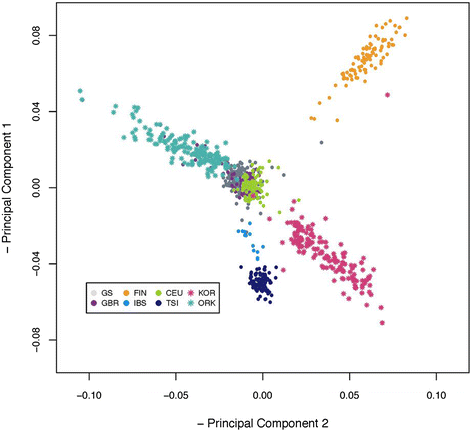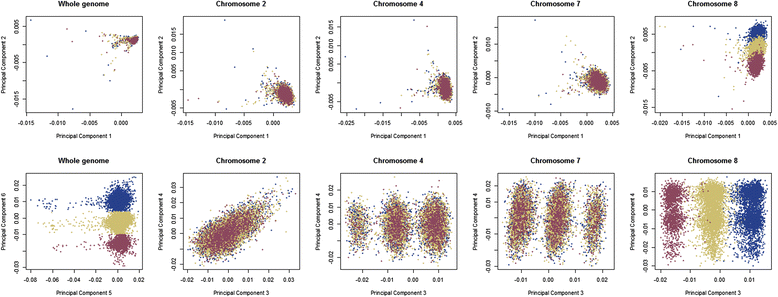Recent genomic heritage in Scotland
- PMID: 26048416
- PMCID: PMC4458001
- DOI: 10.1186/s12864-015-1605-2
Recent genomic heritage in Scotland
Abstract
Background: The Generation Scotland Scottish Family Health Study (GS:SFHS) includes 23,960 participants from across Scotland with records for many health-related traits and environmental covariates. Genotypes at ~700 K SNPs are currently available for 10,000 participants. The cohort was designed as a resource for genetic and health related research and the study of complex traits. In this study we developed a suite of analyses to disentangle the genomic differentiation within GS:SFHS individuals to describe and optimise the sample and methods for future analyses.
Results: We combined the genotypic information of GS:SFHS with 1092 individuals from the 1000 Genomes project and estimated their genomic relationships. Then, we performed Principal Component Analyses of the resulting relationships to investigate the genomic origin of different groups. We characterised two groups of individuals: those with a few sparse rare markers in the genome, and those with several large rare haplotypes which might represent relatively recent exogenous ancestors. We identified some individuals with likely Italian ancestry and a group with some potential African/Asian ancestry. An analysis of homozygosity in the GS:SFHS sample revealed a very similar pattern to other European populations. We also identified an individual carrying a chromosome 1 uniparental disomy. We found evidence of local geographic stratification within the population having impact on the genomic structure.
Conclusions: These findings illuminate the history of the Scottish population and have implications for further analyses such as the study of the contributions of common and rare variants to trait heritabilities and the evaluation of genomic and phenotypic prediction of disease.
Figures






References
-
- Smith BH, Campbell A, Linksted P, Fitzpatrick B, Jackson C, Kerr SM, et al. Cohort profile: Generation Scotland: Scottish Family Health Study (GS:SFHS). The study, its participants and their potential for genetic research on health and illness. Int J Epidemiol. 2012;42(3):689–700. doi: 10.1093/ije/dys084. - DOI - PubMed
Publication types
MeSH terms
Grants and funding
LinkOut - more resources
Full Text Sources
Other Literature Sources

